Most cited
- Page Path
-
- HOME
- BROWSE ARTICLES
- Most cited
Most-cited articles are from the articles published during the last two years (2023 ~ ).
- Editorial
- Gastroenterology
- Is there a link between social media usage and functional gastrointestinal disorders in children?
- Hae Jeong Lee
- Clin Exp Pediatr. 2023;66(4):169-170. Published online March 23, 2023
-
Social media use has potential benefits and risks, including links to adverse health problems in children such as functional gastrointestinal disorders (FGIDs). Screen time control, emotional support, and parental guidance can help children navigate social media safely and reduce the risk of developing FGIDs.
- Letter to the Editor
- Endocrinology
- Accuracy of predicted adult height using the Greulich-Pyle method and artificial intelligence medical device
- Dongho Cho, Yun Sun Choi, Hayun Oh, Young min Ahn, Ji-Young Seo
- Clin Exp Pediatr. 2023;66(3):145-147. Published online January 25, 2023
-
- Original Article
- Developmental and Behavioral Medicine
- Attention-deficit/hyperactive-impulsive disorder symptoms among grade 1 students with reading disorder in Thailand
- Patcharapun Sarisuta, Issarapa Chunsuwan, Tippawan Hansakunachai, Paskorn Sritipsukho
- Clin Exp Pediatr. 2023;66(11):485-492. Published online October 24, 2023
-
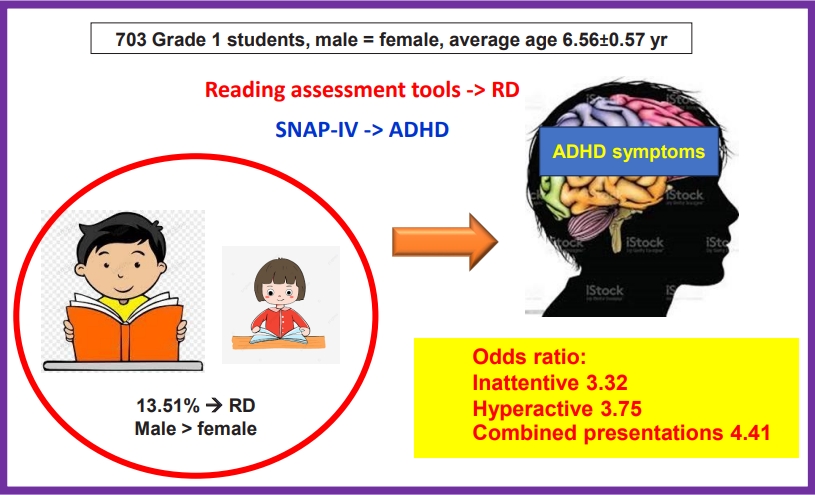
Question: Would students with reading disorder have a significantly higher prevalence of attention-deficit/hyperactiveimpulsive disorder (ADHD) symptoms than neurotypical students?
Finding: Students at risk of reading disorder exhibited significant ADHD symptoms compared with those not at risk of reading disorder according to all presentations of teacher assessments versus only for predominantly inattentive presentations of the parental assessments.
Meaning: Students with reading disorder have a significantly higher prevalence of ADHD symptoms than neurotypical students. Sex, parental education level, average family income, and children’s school affiliation significantly influenced reading disorder prevalence.
- Editorial
- Pulmonology
- Community-acquired pneumonia in Korean children: time to read between the lines
- Dong In Suh
- Clin Exp Pediatr. 2023;66(1):22-23. Published online November 10, 2022
-
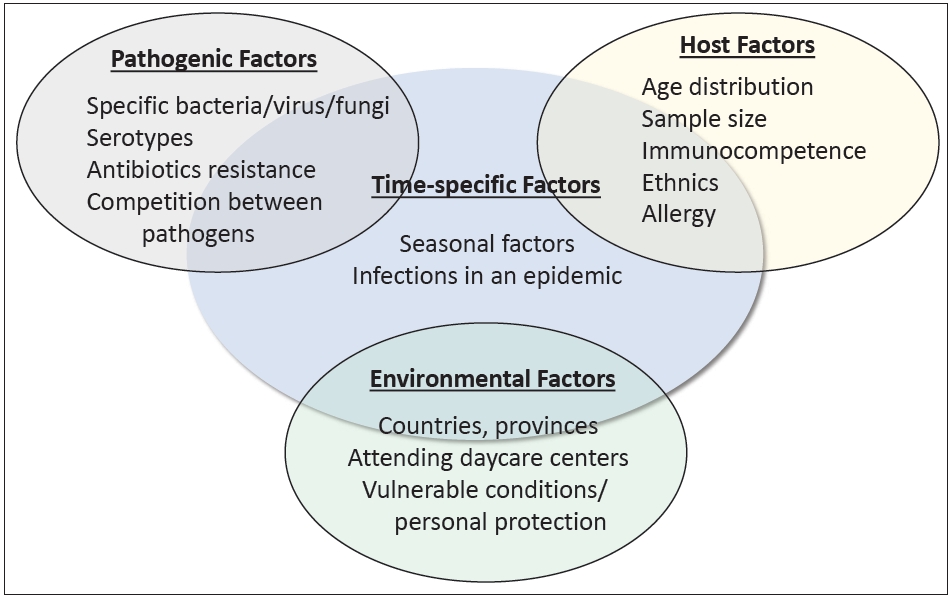
· Various studies have reported the etiology of community-acquired pneumonia (CAP) in Korean children
· Factors other than etiology are equally important to a compre hensive understanding of CAP
· Knowledge from archived reports is no longer directly applicable to the current CAP and requires careful modification
- Review Article
- Other
- Artificial intelligence in pediatric healthcare: current applications, potential, and implementation considerations
- Taejin Park, In-Hee Lee, Seung Wook Lee, Sek Won Kong
- Clin Exp Pediatr. 2025;68(9):641-651. Published online June 25, 2025
-

Artificial intelligence (AI) offers potential benefits in pediatric care, but its real-world adoption requires clinician literacy, ethical and legal safeguards, and cautious implementation. Large language models are emerging across healthcare, but their use in pediatric clinical practice remains premature. Thus, the cautious and accountable implementation of AI is crucial to preventing unintended harm and realizing its potential.
- Original Article
- Basic Research
- Linezolid mitigates tissue injury in experimental model of pediatric testicular torsion: TLR-4/MAPK/NF-κB involvement
- Moein Ghasemi, Abolfazl Basiri, Houman Kazemzadeh, Mohammad Amin Manavi, Seyed Mohammad Tavangar, Ahmad Reza Dehpour, Hamed Shafaroodi
- Clin Exp Pediatr. 2025;68(9):700-711. Published online August 26, 2025
-

Question: What pharmacological strategies can limit ischemia-reperfusion injury in pediatric patients with testicular torsion?
Finding: In a rat model of testicular torsion, linezolid reduced oxidative stress, inflammation, and tissue injury via the Toll-like receptor 4/mitogen-activated protein kinase/nuclear factor kappa beta pathway.
Meaning: Linezolid may offer a pharmacological approach to attenuate testicular damage in pediatric patients with testicular torsion, warranting further clinical investigation.
- Neurology
- Establishing an induced pluripotent stem cell bank using urine cells from pediatric patients with neurogenetic diseases
- Hien Bao Dieu Thai, WonWoo Jung, Sol Choi, Woo Joong Kim, JangSup Moon, ByungChan Lim
- Clin Exp Pediatr. 2025;68(8):569-577. Published online April 1, 2025
-
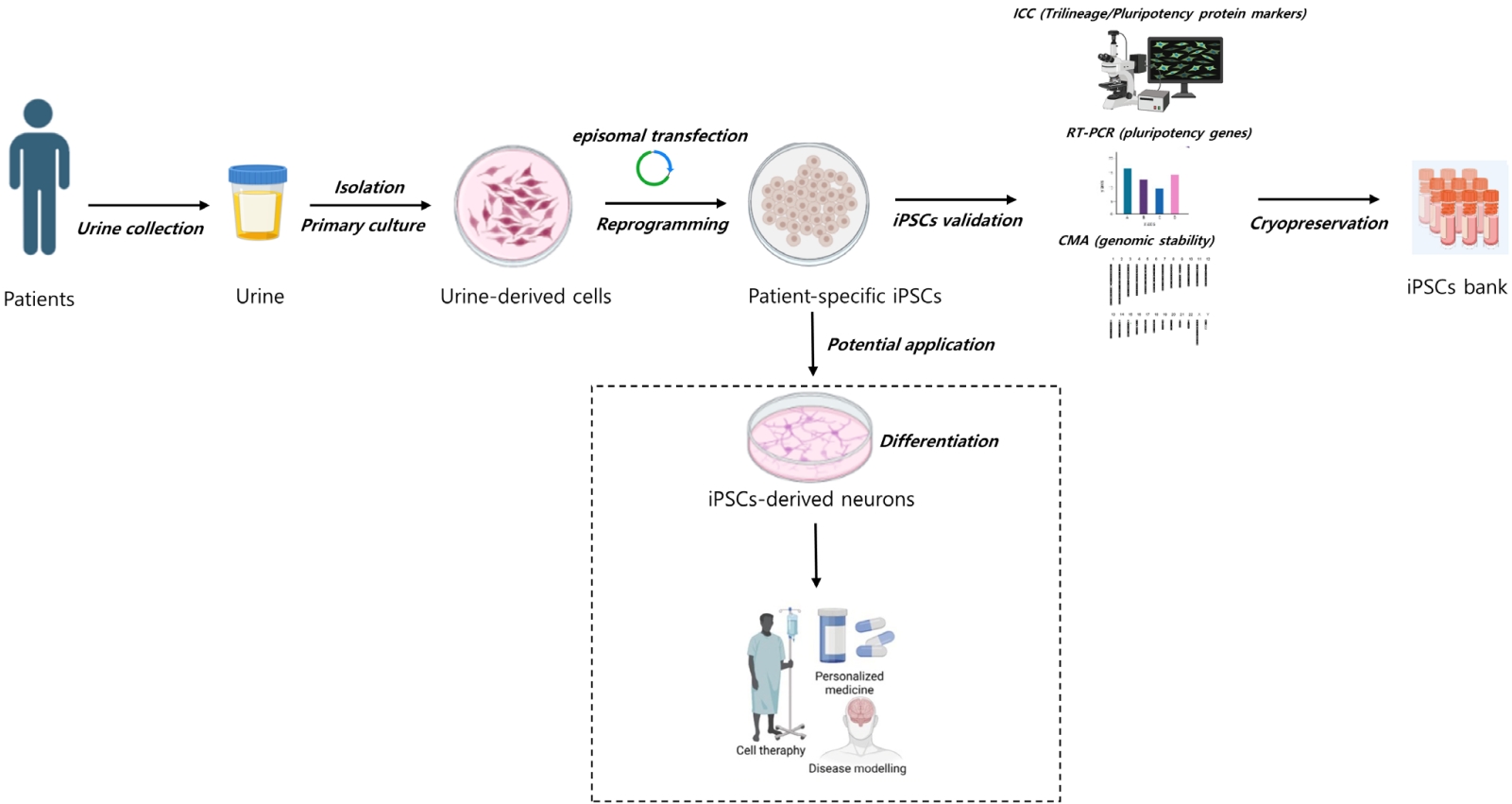
Question: What can be used to create a reliable supply of somatic cells for induced pluripotent stem cells (iPSCs) generation and standardize procedures for building an iPSC bank for researching pediatric neurogenetic disorders?
Findings: Noninvasively acquired urine cells are a desirable cell source for iPSC reprogramming.
Meaning: An iPSC bank can be created from diverse patient cell sources and offer a useful resource for translating research results into clinical therapy for pediatric neurogenetic disorders.
- General Pediatrics
- Liposomal SunActive versus conventional iron for treatment of iron-deficiency anemia in children aged 2–12 years: a prospective randomized controlled trial
- Wael A. Bahbah, Yasmin A.H.S. Younis, Hanan Salama Elbelouny, Asmaa A. Mahmoud
- Clin Exp Pediatr. 2025;68(8):608-615. Published online July 18, 2025
-
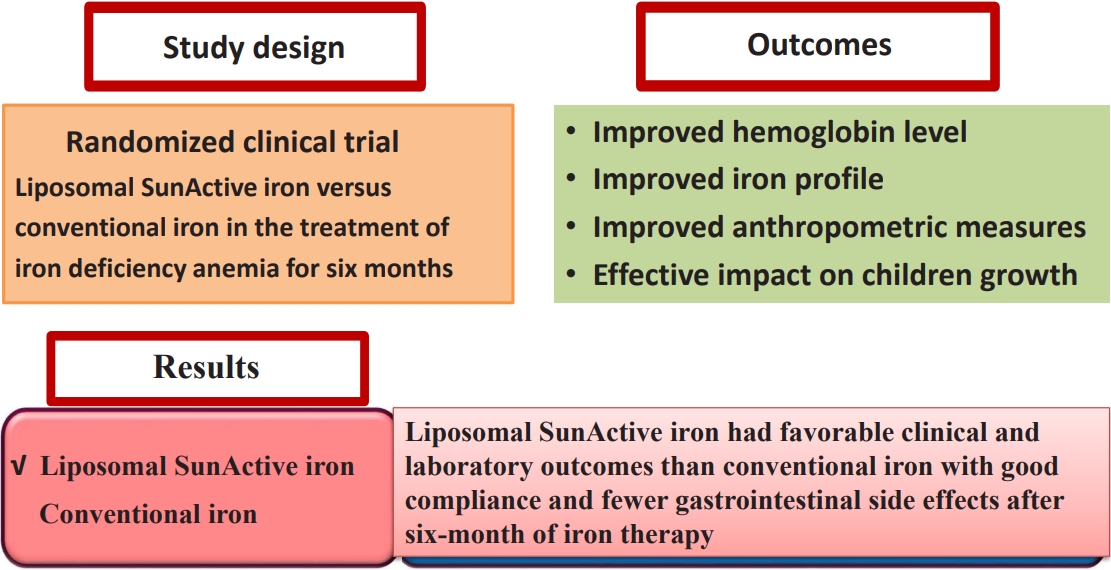
Background: Liposomal iron, a novel oral formulation of ferric pyrophosphate that demonstrates improved gastrointestinal absorption and bioavailability with fewer side effects than conventional iron, represents a significant advancement in the treatment of iron-deficiency anemia (IDA).
Purpose: To conduct an in-depth comparative study of liposomal SunActive and conventional iron supplements (iron polymaltose complex) for treating IDA in children aged 2–12 years Methods: This...
- Review Article
- Immunology
- NLRP3 inflammasome: a key player in neonatal brain injury
- Cagla Kiser, Ilkcan Ercan, Defne Engur, Sermin Genc
- Clin Exp Pediatr. 2025;68(7):475-485. Published online April 1, 2025
-

Hypoxic-ischemic encephalopathy is the major cause of neonatal brain injury. NOD-like receptor family pyrin domain containing 3 inflammasome activation leads to neuroinflammation, which significantly affects newborn mortality. The establishment of preventive and therapeutic strategies against brain damage requires a thorough understanding of the mechanisms underlying neuroinflammation and inflammasome activation in the neonatal brain.
- Original Article
- Oncology
- Prognostic role of mid-regional pro-adrenomedullin in predicting infection in pediatric cancer with febrile neutropenia
- Seham M. Ragab, Sara Mahmoud El-Deeb, Ahmed Saeed, Asmaa A. Mahmoud
- Clin Exp Pediatr. 2025;68(6):445-453. Published online January 13, 2025
-

· Infection remains a leading cause of death in febrile neutropenia (FN).
· Mid-regional pro-adrenomedullin (MR-ProADM) levels are higher among patients with FN and a bacterial infection.
· A longer FN duration and hospital stay length as well as elevated C-reactive protein, procalcitonin, and MR-ProADM levels are significant risk factors for mortality.
- Editorial
- Other
- Further research on impact of microplastics on children's health is essential to protecting future generations
- Jongin Lee, Dong-Wook Lee
- Clin Exp Pediatr. 2025;68(5):359-361. Published online November 13, 2024
-
· The ecological impacts of microplastics have been documented. It was recently recognized that they can directly or indirectly cause diseases in humans.
· There are few established methods for assessing human exposure to microplastics.
· Standardization of exposure assessments and large-scale epidemiological studies are required to explore the human effects of microplastics.
- Original Article
- Pulmonology
- Impact of obesity on pulmonary function of preschool children: an impulse oscillometry study
- Anuvat Klubdaeng, Kanokporn Udomittipong, Apinya Palamit, Pawinee Charoensittisup, Khunphon Mahoran
- Clin Exp Pediatr. 2025;68(4):319-325. Published online November 13, 2024
-

Question: Does obesity in preschool children affect lung function, and which obesity indices can predict such alterations?
Finding: Preschool children with obesity exhibit impaired lung function characterized by elevated total and peripheral airway resistance. Waist-to-height ratio was the strongest predictor of such changes.
Meaning: Early obesity prevention and treatment are needed. Monitoring waist-to-height ratio, body weight, and body mass index may help identify children at risk of altered lung function.
- Review Article
- Neurology
- Cerebral organoid research for pediatric patients with neurological disorders
- Jin Eun, Jung Eun Lee, Seung Ho Yang
- Clin Exp Pediatr. 2025;68(4):269-277. Published online November 28, 2024
-

Cerebral organoids obtained from human induced pluripotent stem cells are transforming the study of pediatric neurological diseases by providing more accurate models of human brain development and pathology. These advancements have improved pathology modeling and the potential for novel therapeutic approaches despite existing challenges such as reproducibility and vascularization.
- Original Article
- Nephrology (Genitourinary)
- C3 glomerulopathy in children: experience at a resource-limited center
- Soumya Reddy, Abhishek Ghante, Mahesha Vankalakunti, Anil Vasudevan
- Clin Exp Pediatr. 2025;68(4):311-318. Published online November 28, 2024
-

Question: What are the clinicopathological features and outcomes of pediatric C3 glomerulopathy (C3G) in resource-limited settings?
Finding: Children with C3G in resource-limited settings have significant morbidities, and most experience kidney sequelae despite treatment. Electron microscopy was performed in only 50% of our patients, while none received complement assays or genetic testing.
Meaning: Pediatric C3G presentation, management, and kidney outcomes vary. Its thorough evaluation and management are challenging in resource-limited settings.
- Review Article
- Cardiology
- Lifelong impact of elevated blood pressure from childhood to adulthood
- Junhyun Kwon, Eunji Kim
- Clin Exp Pediatr. 2025;68(4):278-286. Published online November 28, 2024
-

· Childhood blood pressure (BP) is significantly associated with adult hypertension and cardiovascular disease.
· Despite ongoing debate regarding the need for regular BP screening and early pharmacotherapy in children, the benefits of optimizing BP throughout childhood are clear.
· Childhood presents a critical window for normalizing BP through lifestyle modifications such as reducing sodium intake and increasing physical activity to promote lifelong cardiovascular health and prevent longterm complications.
- Gastroenterology
- Practical concepts and strategies for early diagnosis and management of eosinophilic gastrointestinal disorders in East-Asian children
- Byung-Ho Choe
- Clin Exp Pediatr. 2025;68(3):185-198. Published online November 13, 2024
-
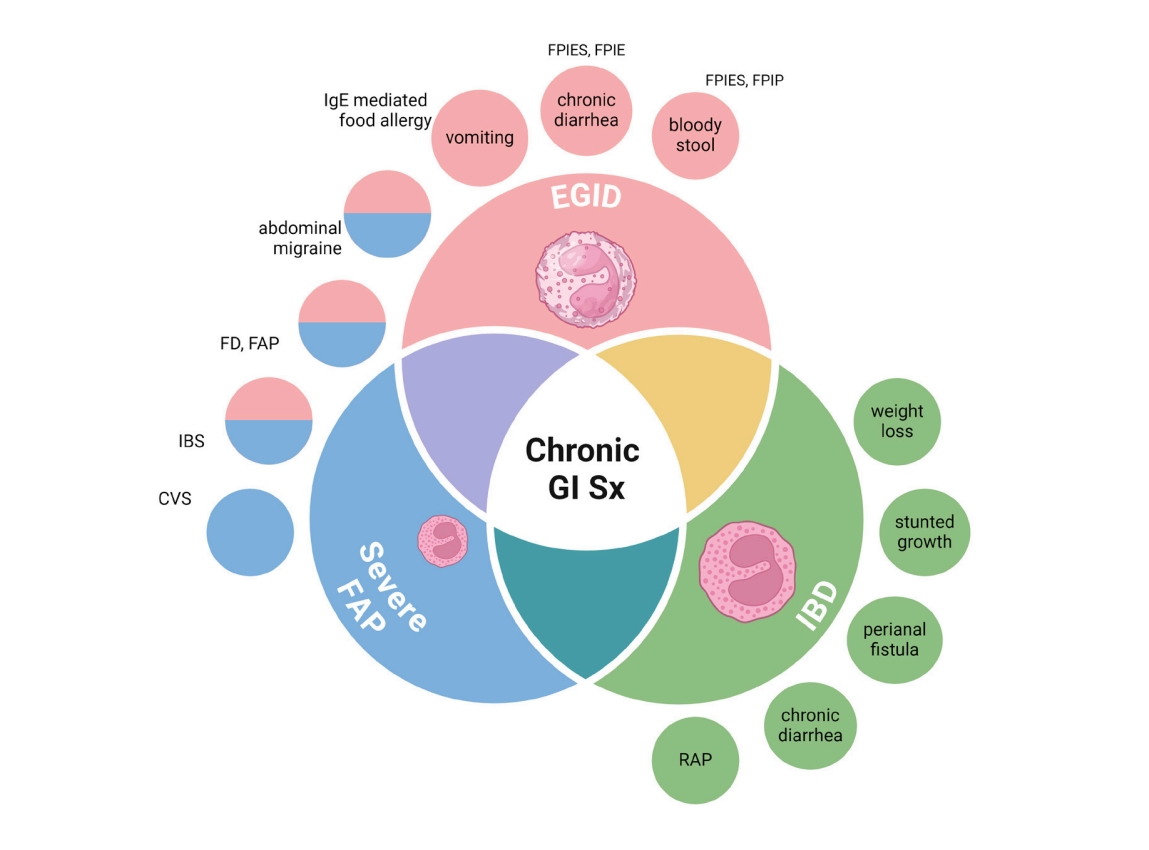
Eosinophilic gastrointestinal disorders (EGIDs) often coexist with functional gastrointestinal disorders (FGIDs) and other IgE or non-IgE mediated GI diseases. Diagnosing EGIDs requires a high index of suspicion and a comprehensive approach to differentiate them from conditions like inflammatory bowel disease. Tests such as fecal calprotectin and biopsies aid in severe cases. Maintaining a food diary helps identify triggers for long-term elimination. Awareness and education are key to effective management.
- Original Article
- Genetics and Metabolism
- Long-term follow-up of neurocognitive function in patients with citrin deficiency and cholestasis
- Meng-Ju Melody Tsai, Jung-Chi Chang, Heng-Yu Lu, Susan Shur-Fen Gau, Yin-Hsiu Chien, Wuh-Liang Hwu, Yen-Hsuan Ni, Huey-Ling Chen, Ni-Chung Lee
- Clin Exp Pediatr. 2025;68(3):257-265. Published online November 28, 2024
-
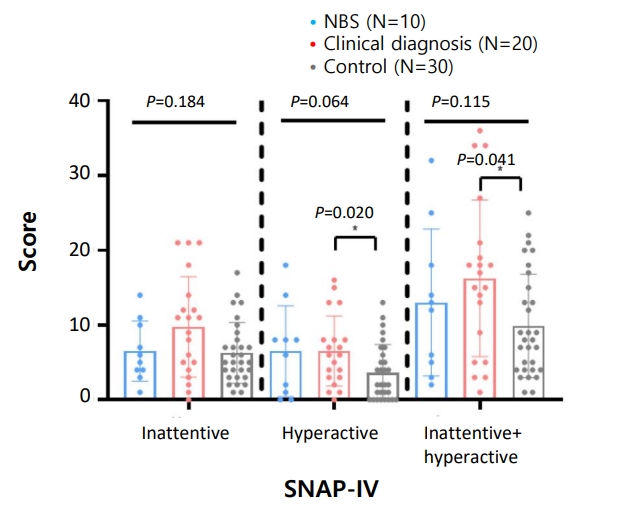
Question: Do transient metabolic disturbances in early childhood due to citrin deficiency have lasting effects on neurocognitive function?
Finding: Children with citrin deficiency have a higher prevalence of ADHD compared to the general population, with elevated ammonia levels in infancy associated with increased hyperactivity-impulsivity risk.
Meaning: Metabolic disturbances in early childhood due to citrin deficiency may contribute to long-term neurocognitive impacts, particularly ADHD, while IQ and life outcomes generally remain normal.
- Review Article
- General Pediatrics
- Prevalence of childhood overweight and obesity in Malaysia: a systematic review and meta-analysis
- Ker Yang Chua, Ker Yung Chua, Karuthan Chinna, Chooi Ling Lim, Maheeka Seneviwickrama
- Clin Exp Pediatr. 2025;68(2):115-126. Published online November 13, 2024
-
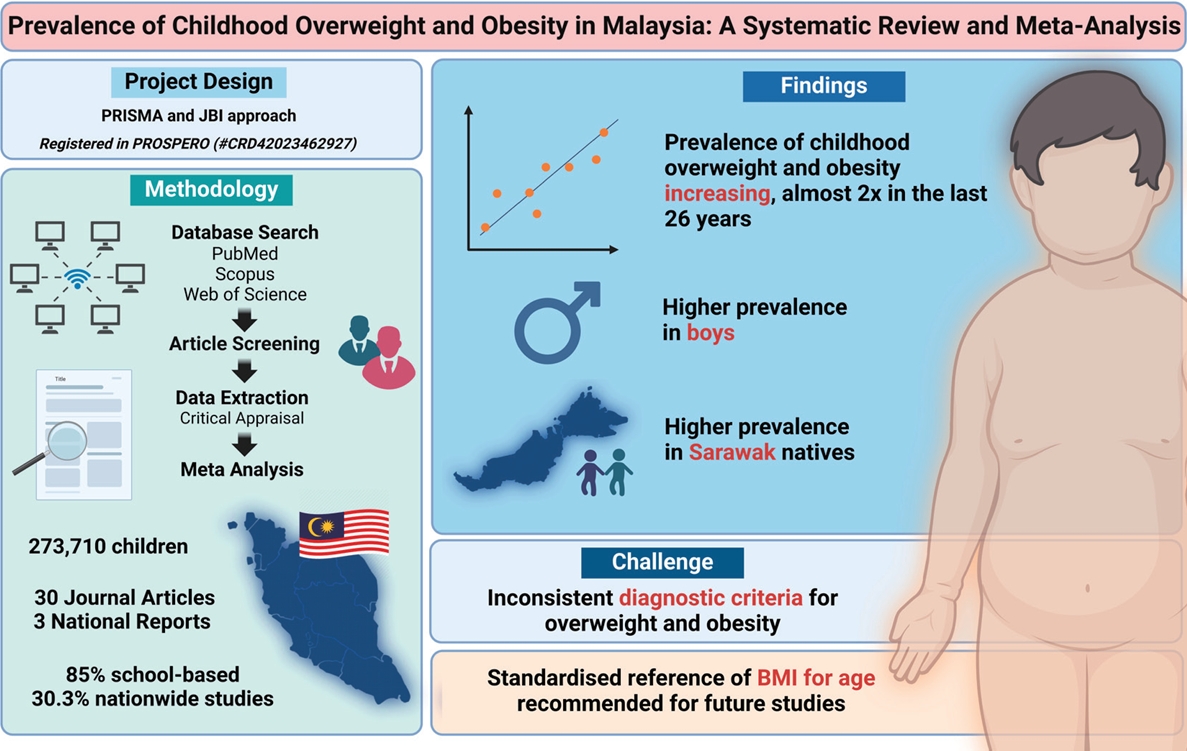
The incidence of childhood obesity is increasing worldwide. National surveys in Malaysia have shown similar trends. This review aimed to increase our understanding of the prevalence and associated factors of childhood overweight, obesity, and excess weight in Malaysia. A systematic review and meta-analysis were conducted of studies reporting the prevalence of overweight and obesity in Malaysian children aged <18 years....
- Original Article
- Neonatology (Perinatology)
- Effect of high-frequency oscillatory ventilation with intermittent sigh breaths on carbon dioxide levels in neonates
- Kulthida Baingam, Anucha Thatrimontrichai, Manapat Praditaukrit, Gunlawadee Maneenil, Supaporn Dissaneevate
- Clin Exp Pediatr. 2025;68(2):178-184. Published online November 13, 2024
-

Question: Can sigh breaths (Sighs) application during high-frequency oscillatory ventilation (HFOV) decrease partial pressure of carbon dioxide (PaCO2) levels?
Finding: The mean PaCO2 level after Sighs during HFOV was significantly decreased compared to that after HFOV alone (mean difference, -3.6 mmHg).
Meaning: HFOV plus Sighs functionality can reduce PaCO2 levels. However, further studies are required to conclusively determine the effects of Sighs.
- Gastroenterology
- Differences in immune cells and gene expression in human milk by parity on integrated scRNA sequencing
- Dae Yong Yi, Hong-Jai Park, Min Sun Shin, Hyoungsu Kim, Sang Jin Lee, Insoo Kang
- Clin Exp Pediatr. 2025;68(2):141-152. Published online January 10, 2025
-

Question: Is there a difference in immune cells in human breast milk by parity?
Finding: There were higher proportions of monocytes and T/B cells in the primiparous and multiparous group, respectively. The expression of genes with a direct role in the infant immune system and immune response-related genes were highest in the primiparous group
Meaning: There were parity-dependent differences in the expression of genes between innate and adaptive immune cells.
- Infection
- Evolving treatment strategies for invasive Streptococcus pyogenes in children in the postpandemic era
- Laura Buricchi, Giuseppe Indolfi, Marco Renni, Elisabetta Venturini, Luisa Galli, Elena Chiappini
- Clin Exp Pediatr. 2025;68(11):921-931. Published online August 11, 2025
-

Question: What are the roles of linezolid, intravenous immunoglobulin (IVIG), and corticosteroids in pediatric invasive group A streptococcal infection (iGAS)? Can any improve outcomes beyond beta-lactams and clindamycin?
Finding: Two of 46 patients with iGAS died. Nearly all received beta-lactams plus clindamycin. Linezolid was effective in refractory cases. IVIG and corticosteroids had variable efficacies.
Meaning: Linezolid may be valuable in refractory cases. IVIG may be considered in severe presentations. The role of corticosteroids remains less clearly defined.
- Endocrinology
- Long-term epidemiological insights into rickets: a nationwide population-based retrospective study
- Chun-Hao Chu, Ying-Chuan Chen, Pei-Yao Liu, Chun-Chieh Hu, Yu-Lung Lin, Feng-Chih Kuo, Chieh-Hua Lu, Tzu-Ju Hsu, Yu-Tung Hung, Fuu-Jen Tsai, Chien-Ming Lin
- Clin Exp Pediatr. 2025;68(11):879-891. Published online August 20, 2025
-

Question: What are the nationwide trends and mortality risk factors of nutritional versus hereditary rickets among children in Asia?
Finding: In 2012–2018, the incidence of rickets steadily increased, whereas mortality rates declined. Mortality is associated with a low household income, anemia, chronic kidney disease, secondary hyperparathyroidism, and a prolonged hospital stay.
Meaning: Early diagnosis and targeted interventions addressing social and medical vulnerabilities are critical to reducing ricket-related mortality.
- Infection
- Role of miRNA-146a and miRNA-125b in Helicobacter pylori
- Nashwa Farouk Mohamed, Ola G.A. Behairy, Manal S. EL-Defrawy, Mona Mahmoud Elsayed, Naglaa F. Alhusseini
- Clin Exp Pediatr. 2025;68(10):781-789. Published online April 1, 2025
-

Question: Why is the early detection of Helicobacter pylori-associated gastritis in children important?
Finding: The early detection of H. pylori-related gastritis is crucial for its effective management, especially in pediatric patients with dyspepsia.
Meaning: The use of miRNA signatures could detect early gastritis, enabling timely H. pylori eradication treatment to mitigate growth delays and cancer risk.
- Carbapenem resistance in gram-negative pathogens in an Iranian hospital: high prevalence of OXA-type carbapenemase genes
- Setareh Mamishi, Reihaneh Hosseinpour Sadeghi, Sadaf Sajedi Moghaddam, Babak Pourakbari, Shiva Poormohammadi, Maryam Sotoudeh Anvari, Shima Mahmoudi
- Clin Exp Pediatr. 2025;68(1):65-72. Published online October 31, 2024
-

Question: What is the prevalence of carbapenem resistance in gram-negative bacteria and associated carbapenemase genes?
Findings: This study identified a notable prevalence of carbapenem-resistant gram-negative isolates, with Escherichia coli being the predominant contributor, follow ed by Klebsiella pneumoniae, Acinetobacter baumannii, while bla OXA48 was the most prevalent carbapenemase gene.
Meaning: These findings highlight the urgent need for proactive measures including the rapid detection of carbapenemase- producing isolates and effective infection control.
- Neonatology (Perinatology)
- Short-term outcomes of oropharyngeal administration of colostrum in preterm neonates: a double-blind placebocontrolled randomized trial
- Ameneh Lamsehchi, Maryam Shokouhi Solgi, Mohammad Kazem Sabzehei, Behnaz Basiri, Elahe Talebi Ghane, Kiana Kimiaei Asadi, Sina Azadnajafabad
- Clin Exp Pediatr. 2025;68(1):73-79. Published online October 31, 2024
-

Question: What are the short-term outcomes of oropharyngeal administration of colostrum (OAC) in preterm neonates?
Finding: This study demonstrated the significantly lower rates of necrotizing enterocolitis, clinically suspected sepsis, shorter hospital stay, period to full enteral feeding, and antibiotic therapy period in the OAC group.
Meaning: This trial may further expand the clinical application of OAC in premature infants to reduce their length of hospital stay and complications.
- Pulmonology
- Polysomnographic features of children with obesity: body mass index predict severe obstructive sleep apnea in obese children?
- Rungrat Sukharom, Prakarn Tovichien, Kanokporn Udomittipong, Pinyapach Tiamduangtawan, Wattanachai Chotinaiwattarakul
- Clin Exp Pediatr. 2025;68(1):80-90. Published online November 6, 2024
-

Question: How Common is obstructive sleep apnea (OSA) in obese children? OSA is common in obese children, even without habitual snoring.
Finding: Among the subjects, 60.6% had positional OSA, 40.2% had rapid eye movement-related OSA, 59.8% had desaturation, 20.5% had sleep-related hypoventilation, and 5.0% had obesity hypoventilation syndrome. Body mass index (BMI) and neck and waist circumferences were significantly associated with severe OSA.
Meaning: We recommend screening obese children (BMI > 29.2 kg/m2) for OSA.
- Review Article
- Neonatology (Perinatology)
- Need for national guidance regarding proactive care of infants born at 22–23 weeks' gestation
- Ga Won Jeon
- Clin Exp Pediatr. 2025;68(1):53-61. Published online November 13, 2024
-

With advancements in neonatal intensive care, the limit of viability has shifted to 22–23 weeks' gestation, whose survival rates vary across countries and institutions. These rates are not static and can be improved through the proactive and centralized care guided by national protocols, including maternal transfer to high-activity regions with better neonatal intensive care practices before delivery.
- Infection
- Incidence, causative organisms, and risk factors of bloodstream infections in pediatric liver transplant patients: a systematic review
- Mohamad Shieb, Rand Hasanain, Zara Arshad, Faisal A. Nawaz, Rahul Kashyap, Eric J. Stern
- Clin Exp Pediatr. 2024;67(9):427-434. Published online April 5, 2024
-

The overall incidence of bloodstream infections was 23.5%. Gram-negative organisms occur at a much higher rate in pediatric liver transplant recipients then that the general pediatric population. However, when comparing pediatric and adult liver transplant recipients Gram-positive organisms occur with a much higher rate in the pediatric population highlighting the importance of early and broad spectrum antimicrobial coverage when bloodstream infections are suspected.
- Allergy
- Recent advances in food allergen immunotherapy
- You Hoon Jeon, Edwin H. Kim
- Clin Exp Pediatr. 2024;67(8):386-394. Published online December 7, 2023
-

· To enhance the safety of food allergen immunotherapy, alternative approaches such as sublingual immunotherapy, epicutaneous immunotherapy, low-dose oral immunotherapy (OIT), and omalizumab with OIT are being explored.
· Factors such as causative allergen type, natural outgrowth, symptom severity, and patient age should be considered.
· Individualized food allergen immunotherapy plans should be established to determine the most beneficial treatment for each patient.
- Original Article
- Infection
- Construction and validation of predictive models for intravenous immunoglobulin–resistant Kawasaki disease using an interpretable machine learning approach
- Linfan Deng, Jian Zhao, Ting Wang, Bin Liu, Jun Jiang, Peng Jia, Dong Liu, Gang Li
- Clin Exp Pediatr. 2024;67(8):405-414. Published online July 23, 2024
-

Question: Is there a reliable model to predict intravenous immunoglobulin (IVIG)-resistant Kawasaki disease (KD)?
Finding: We constructed 5 machine learning models to predict IVIG-resistant KD. Extreme gradient boosting (XGBoost) model was superior to logistic, support vector machine, light gradient boosting machine and multiple layers perception models. The SHAP (SHapley Additive exPlanations) value interpreted the contribution of each feature in XGBoost model.
Meaning: XGBoost model showed the excellent performance to predict IVIG-resistant KD with explainable and visualizable machine learning algorithm.
-

-
-
6.02024CiteScore98th percentilePowered by
-
Impact Factor3.6
-
- TOPICS
- ARTICLE CATEGORY
- Editorial Office
-
Korean Pediatric Society
#1606 Seocho World Officetel, 19 Seoun-ro, Seocho-ku, Seoul 06732, Korea
Tel: +82-2-3473-7306 Fax: +82-2-3473-7307 E-mail: office@e-cep.org
Clinical and Experimental Pediatrics is an open access journal. All articles are distributed under the terms of the Creative Commons Attribution NonCommercial License (http://creativecommons.org/licenses/by-nc/4.0/)
Copyright © 2025 by Korean Pediatric Society.












